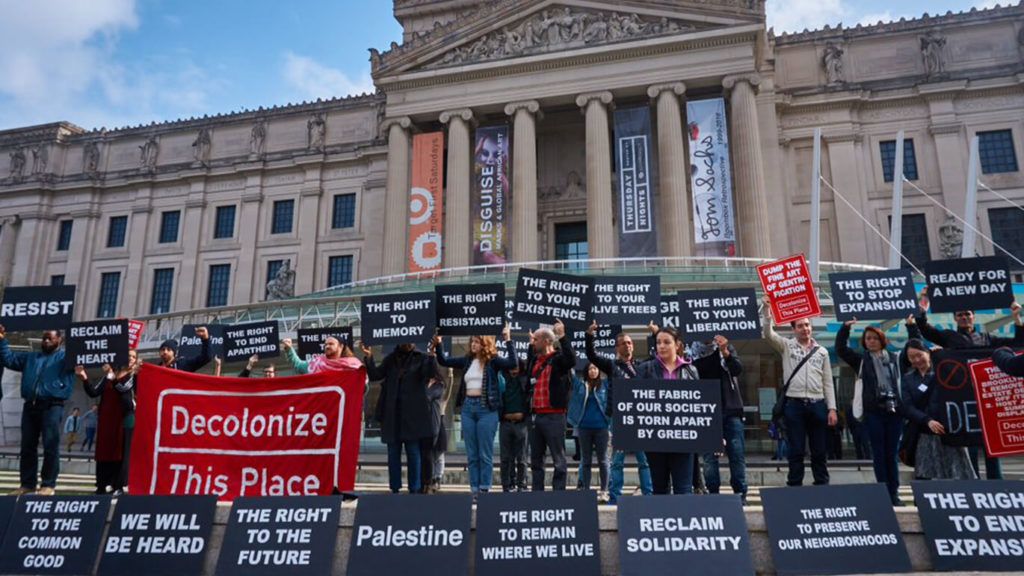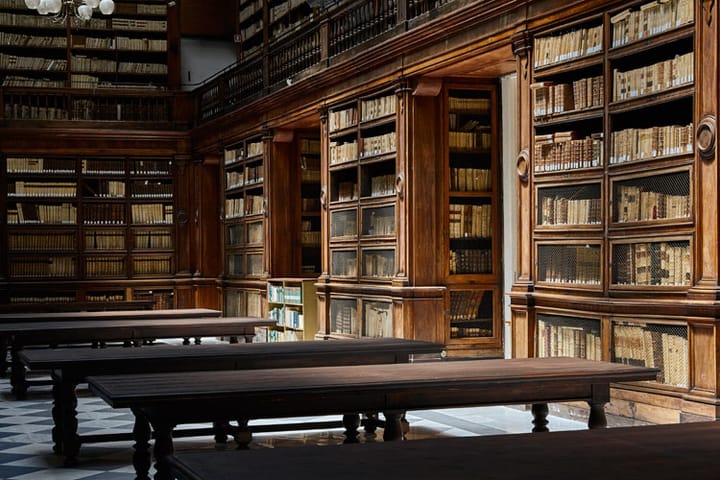The museum is in crisis. In the wake of the COVID-19 pandemic and social uprising centered around Black Lives Matter, conversations around art institutions have jumped to the forefront of calls for decolonization. Yet one major question remains: What will a decolonized museum look like, especially now? Since beginning this study in the summer of 2020, the world has changed dramatically and conversations around a ‘new normal’ have become commonplace. Meanwhile, the murder of George Floyd and the response by individuals, institutions, and corporations posting ‘blackout squares’[i] on Instagram began another conversation, focused on racial equity. This involved simultaneous public calls to consciousness and action centered on antiracism and diversity measures, alongside museums’ posting of action plans within staff teams, reading lists, and effectively ‘black-washing’ their websites. This trend encompasses the ease with which institutions can co-opt a social movement and pay lip service to a topic without fully addressing the concerns being brought up, effectively neutralizing radical calls for change. It is up to us, as museumgoers and art workers, to hold institutions accountable to continue to do the work after museums have used aesthetics in ‘decolonial washing’ – an alibi for sustained change.[ii] As Boaventura de Sousa Santos says: ‘We don’t need alternatives, we need an alternative thinking of alternatives’.[iii]
We can see, six months down the line, how little has changed in the major art institutions of the world. The directors, benefactors, and managers of galleries from San Francisco to London have seen little change in their own positionality, while the front of house (FOH) staff, security, and lower-paid staff struggle to make ends meet. It is important to underline here that these higher positions are held primarily by white people, while the lower positions – the positions put on the frontlines against the public in the midst of a pandemic and who have not received hazard pay, who have their hours and their jobs cut without warning or income assistance, and who do not have the luxury of working from home – are primarily BIPOC (Black, Indigenous, people of color – this term is addressed further in the full body of work). This exact point underlines the issues that so many have called out against museums from the beginning of the recent calls for decolonizing art spaces: how many of these same museums posted anti-racist reading lists and action plans on their website? How many of them followed up in their own space?
The topic of decolonizing museums itself, in regards to this written work, stems from this intersecting moment of COVID and Black Lives Matter (BLM) that marked summer of 2020, but aims to go further, initially asking the pre-pandemic question: Where do you begin the action of decolonizing the art museum? Theoretical bases of calls to decolonize (be it one of the many calls we are seeing, including decolonize your bookshelf, decolonize your diet, or the subject of this work: decolonize art history and the art gallery) may seem disparate. Within the art world, where and how to decolonize remains a major question. Yet, despite the heterogenous nature of this topic, the extent to which coloniality and culture remain intertwined is evident; underlining the close relationship between the two makes clear that these calls are not so heterogeneous after all, and the necessity to challenge this relationship becomes ever clearer. Racial and social justice are similarly not disparate topics, and all closely linked in this conversation which has become so urgent worldwide. Decolonization is not a one-off event, but rather a restructuring of the systems with which we interact daily.
In attempting to answer these questions, I spoke directly to institutions, seeking to bridge the gap between theory and intent to do something versus practical measures in sustained action that can be taken. This dialogic approach granted a lifting of the curtain to what institutions are doing and saying, giving them a voice to speak about these issues in their own spaces. Rather than taking their words at face value, this work seeks to challenge and hold major institutions accountable while looking at potentially decolonial options in practice around the world in contemporary art spaces[iv] – I will not address ethnographic institutions nor questions of restitution. Further, as open letters penned by primarily Black art workers came out alongside my own interview questions, I collected these resources and relayed them along during interviews as possible action steps. This included that of Jasmine Gregory and Yesomi Omulu, as well as the Instagram account @ChangeTheMuseum[v] (who continue to share anonymized stories and action steps within art institutions across the USA). My goal in interviews was to hold art institutions accountable, using their own language posted online to challenge the steps towards decolonizing they seem eager to take. This work is only one piece in a complex compilation of calls for decolonization being discussed contemporaneously around the world, and thus leaves a particular lacuna in the conversation.
Particularly important in interviews were discussions in regard to the crisis of the art world in the face of COVID furloughs, layoffs and the positionality of the museum in the ‘new normal’. This is a pertinent moment for decolonizing to play an active role, as institutions are forced to reshape regardless, with social distancing and safety measures changing how we interact with public spaces and in turn changing how these same public spaces react to audiences. Fieldwork holds a central position in the formation of my argument and the ties together the research that I undertook in the summer of 2020. In carrying out these interviews, I found a collective voice from galleries across the world, where hope for change was a common thread but actions toward change were by and large a blur of unknown steps, differing in the context of each gallery and summarized best by the director of the Power Plant Contemporary Art Gallery in Toronto: ‘If you want to make a change, just do it.’ It is not about having another audit, or a diversity staff team member, but rather about restructuring internal orders to reflect the world at large. This is as simple as hiring BIPOC curators – whether or not for curating an exhibition of BIPOC art.
Coming back to this study in the second lockdown in the UK and stricter measures across Europe (November 2020) has made clearer the disparate nature of the workforce in the museum at this time – as previously mentioned, the wealthy museum professionals and board members (again, primarily white) stayed home during reopenings late this summer continuing to earn high salaries, while the front of house staff (again, primarily BIPOC) put their health at risk without hazard pay and often without further addressing of the issues of race and racism in institutions brought up throughout the summer. Instagram account @ChangetheMuseum called for a boycott of museums in October for these very reasons,[vi] putting further focus on issues within arts institutions as the effects of COVID continue even now to lead to redundancies and impact the greater conversation of racial inequality.
Working from theory to conversation presents an opportunity to build this discussion and more deeply address the issues at play. In the body of this text, I first offer a theoretical summary of topics of decolonization. These concepts and texts will guide the rest of the work. The urgency of the current moment is also importantly not without precedent, and further history of museum critiques is addressed. The theory of decolonization helps take the word from a metaphor, oversaturated now in conversations from museums to diets, and solidifies it as an active struggle for reclamation. I draw theory from Latin American authors, such as Walter Mignolo and Anibal Quijano as well as postcolonial theorists Frantz Fanon and Aimé Césaire as the basis for this term. Decolonization is not about writing texts to solve the issues of western coloniality, but instead an active response, actions that must be taken. Decolonizing is not a friendly affair, rather a process deeply rooted in conflict and struggle. A decolonial museum must be decolonial in its existence, with every individual and object within taking part. This means a reimagination, and inherent destruction,[vii] of the museum as we know it. Institutions are built on a specific history and within a framework that will not change with only the diversification measures, quotas, and antiracist reading lists only being proposed in the wake of social uprisings.
From here, my work is informed by interviews that took place between May and August 2020 via Skype or Zoom video calls with various museum professionals. As mentioned, the opportunity to speak with professionals offered them a chance to unveil what is occurring in their spaces and how in general they are responding to pressure to change. These calls for transformation were further addressed in my attendance at multiple conferences which took place during this time period, also through internet calls, and hosted by more ‘radical’ museum thinkers – be they academics, museumgoers, or creators.
In speaking to these professionals, this work addresses the local; looking at public audiences and addressing the call to action to create a safe environment in museums are two topics which are under constant review in the COVID landscape, as we continually prepare for the next lockdown. This safe environment has a double meaning – safe from the structures of power that delineate our lives, as well as safe from the virus which threatens the global community. The combination of COVID and civil uprising across the globe has put the art institution at a peculiar nexus, where they now more deeply realize their role in the local community. The decolonial options in this are further interrogated in the context of the interviews with museums such as the Museu d’Art Contemporani de Barcelona and the Serpentine Galleries. As travel is severely limited and with international audiences being the primary targets for so many institutions, museums must re-evaluate to whom they are speaking and how. This poses a unique set of issues. Now, we can see a shift in positionality as institutions look at who surrounds them, and who they can bring into their spaces lacking international audiences (who previously traveled around the globe for leisure, biennales, or art fairs). Further, a general feeling of coldness and elitism has often kept the local public out of art spaces. The art museum is generally seen as an activity for the wealthy, white, and educated to enjoy, with visitors of color often noting that they feel followed by security, unrepresented in displays, and with language used being inaccessible to those without a degree in the arts. These barriers, along with entry costs and the situation of museums in often affluent areas of cities, limit access. Addressing local audiences is both novel and a long time coming, offering an interesting approach to decolonizing in action.
The final section of this work looks at the internal structures and actions of institutions. This includes a brief discussion of curatorial actions that can be taken, and how diversity measures and task forces can be used as forces of change as opposed to reinstating the ‘coloniality of power’. I chose to call attention to action plans, antiracist reading lists, and other such methods in use in this explosion of information that took off in early June, while simultaneously looking at public diversity reports published, and analyzing museums’ online presence in regard to BLM prior to interviews. This allowed each interview to be more targeted and conversational, with respondents seeking to be more informed and make changes accordingly. These interviews focused on galleries such as Tate and KW Institute for Contemporary art in Berlin, although nearly every institution made announcements regarding internal actions they would be taking to address the topic of racial and social inequality in their spaces. Following up on this study months later allows an opportunity to call attention to what has not changed and what urgency has been lost in institutions due to factors such as pandemic fatigue and the United States’ presidential election.
Decolonizing is not a checklist that will be completed; these processes are long and will require thinking and parsing out in a transparent manner if we are to eventually see a destroyed, rebuilt, decolonial art space. The aspect of staff diversification must be a mission built into the art museum alongside decolonizing arts education, accessibility, history, and so on. Many institutions will have posted their ‘blackout square’ on Instagram and shared an antiracist literature list, but will not have questioned power structures within their spaces. The ‘blackout square’ becomes another tool of capitalism, a way to virtue signal and elicit a response (maybe done with good intentions) but which will not see drastic changes to museums. Upsetting structural orders requires work from the inside, and from the top down. Following the blackout square and public letters, there have been various levels of dedication to this work. When speaking to institutions, it was clear across the board that many jumped into this moment with unsustainable goals and have had to reassess. My work initially set out to hold art institutions accountable in this journey, but in a sense is passing a baton to the reader, offering an inside perspective and a call to action to press museums to continue, and to go further. Months later, as @ChangetheMuseum and colleagues within the art world report back, the moment has ‘passed’; racism within ivory tower walls continues unchecked, and stories of individual micro- and macroaggressions in these spaces have not slowed.
I propose that the decolonial option in museums and galleries across the world must go deep into the background of whose history is being told, how and why professionals are chosen, their monetary influence and capital gains, the networks they can access, and the practices of the museum beyond the social justice/social media one-off actions. Digging into Fanon’s tabula rasa[viii] – the decolonized museum, as has been suggested to me throughout multiple interviews from Berlin to New York to Barcelona, would look nothing like the museum as we know it now. It would be a ‘program of complete disorder’.[ix] For many this instills fear – the fear of the unknown, the fear of revolution, the fear of losing power – but for others, this is an inspiring option for collective imagination to take the lead, as destruction of art spaces’ internal orders leads to rebirth and opportunities for justice.
[i] For more information see: Heilweil, Rebecca. “Why People Are Posting Black Squares on Instagram.” Vox.
[ii] Siegenthaler, Fiona and Allain Bonilla, Marie-laure. “Introduction: Decolonial Processes in Swiss Academia and Cultural Institutions.” pg 4.
[iii] de Sousa Santos, Boaventura. “Toward an Aesthetics of the Epistemologies of the South (Twenty-Two Theses).” pg. 133
[iv] In the US and UK ‘gallery’ has a different meaning: in the US this is most often a commercial space – in the UK a gallery is an institution where art works are shown, often not in a collecting context. The terms ‘museum’ and ‘gallery’ are used interchangeably in this work.
[v] See Appendix C.
[vi] See; https://www.instagram.com/p/CFrf1N-Fsq8/?utm_source=ig_web_copy_link
[vii] See Death to Museums monthly unconference, destruction does not mean physically ripping apart structures but doing internal work to change structural orders: available at: deathtomuseums.com/
[viii] Fanon, Frantz. The Wretched of the Earth. pg 35
[ix] Ibid pg 36



